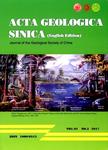Trilobite Biostratigraphy of the lower Paleozoic(Cambrian–Ordovician)Joseon Supergroup,Taebaeksan Basin,Korea
Trilobite Biostratigraphy of the lower Paleozoic(Cambrian–Ordovician) Joseon Supergroup,Taebaeksan Basin,Korea作者机构:Research Institute of Basic SciencesSeoul National UniversitySeoul 151-747Korea Ministry of ScienceICTand Future PlanningGwacheon 427-700Korea Korea Institute of Geoscience and Mineral ResourcesDaejeon 305-350Korea Korea Polar Research InstituteIncheon 406-840Korea
出 版 物:《Acta Geologica Sinica(English Edition)》 (地质学报(英文版))
年 卷 期:2016年第90卷第6期
页 面:1976-1999页
核心收录:
学科分类:070903[理学-古生物学与地层学(含:古人类学)] 0709[理学-地质学] 07[理学]
基 金:supported by a grant from the National Research Foundation of Korea(Grant No.NRF-2014R1A1A2002851)
主 题:Trilobites biostratigraphy Cambrian–Ordovician Taebaeksan Basin
摘 要:In Korea, trilobites are among the most intensively studied fossil groups in the past century and provide invaluable information about lower Paleozoic stratigraphy, paleogeography, and tectonics of the Korean Peninsula. Trilobites occur in the lower Paleozoic Joseon Supergroup of the Taebaeksan Basin which was part of the Sino-Korean Craton in the Paleozoic. The Joseon Supergroup is divided into the Taebaek, Yeongwol, and Mungyeong groups. The Taebaek and Yeongwol groups are richly fossiliferous, while the Mungyeong Group is poorly fossiliferous. Contrasting trilobite faunal contents of the Taebaek and Yeongwol groups resulted in two separate biostratigraphic schemes for the Cambrian–Ordovician of the Taebaeksan Basin. A total of 22 biozones or fossiliferous horizons were recognized in the Taebaek Group; 19 zones were established in the Yeongwol Group; and four biozones were known from the Mungyeong Group. These trilobite biozones of the Taebaeksan Basin indicate the Joseon Supergroup ranges in age from the Cambrian Series 2 to Middle Ordovician and can be correlated well with the formations of North China, South China, and Australia.



